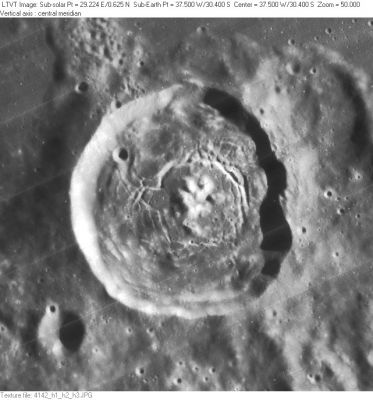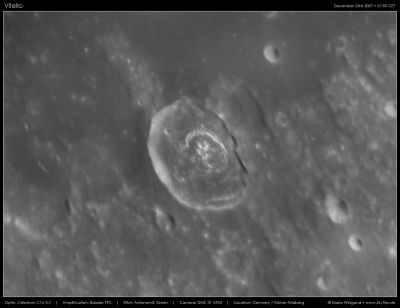Vitello
Contents
Vitello
|
Lat: 30.4°S, Long: 37.5°W, Diam: 42 km, Depth: 1.7 km, Rükl: 62 |


Left: LO-IV-142H Overhead view. The 9-km diameter circular crater in the lower left is Vitello P. The large depression in the upper right is unnamed. Right: Mario Weigand In this Earth-based view, several letttered craters named after Vitello are visible as well as the ghostly arcs of 41-km Lee and 77-km Lee M on the left.
Images
LPOD Photo Gallery Lunar Orbiter Images Apollo Images
- Lunar Orbiter 5 Frame 5168 shows a vertical view of Vitello and its surroundings - DannyCaes Dec 24, 2007
The two boulder tracks on the southern part of Vitello's central peak
- Vitello is perhaps best known for the famous tracks of the two boulders on its central peak. An interesting Lunar Orbiter 5 photograph of those tracks (an extreme close-up) was included on page 236 in the National Geographic of February 1969 (Awesome Views of the Forbidding Moonscape; a nine-page portfolio). - DannyCaes Dec 24, 2007
- Lunar Orbiter 5's online Frame h168-2 shows the two boulder tracks in Vitello. The large boulder with its short chain-like track near centre, and the small boulder with its long thin track near the image's right margin. The shadow of the large boulder is detactable on the LPI's Hi-Res scan of image 168-2, at the southern part of Vitello's central peak. Danny Caes discovered the boulders's true location on the 24th of february 2008. - DannyCaes Feb 24, 2008
Maps
(LAC zone 93C4) LAC map Geologic map
Description
Description: Elger
(IAU Directions) VITELLO.--A very peculiar ring-plain, 28 miles in diameter, on the S. side of the Mare Humorum, remarkable for having another nearly concentric ring-plain, of considerably less altitude within it, and a large bright central boss, overlooking the inner wall, 1,700 feet in height. The outer wall is somewhat irregular, and is broken by gaps and valleys on the S. and N.E. It rises on the W. about 5,000 feet above the Mare, but only about 2,000 above the interior, which includes a crater on its N. side, and some low ridges.
Description: Wikipedia
Additional Information
- Depth data from Kurt Fisher database
- Pike, 1976: 1.7 km
- Arthur, 1974: 2.08 km
- Westfall, 2000: 1.7 km
- Viscardy, 1985: 1.7 km
- Cherrington, 1969: 1.4 km
- According to LTVT the different parts of the west wall shown in LO-IV-142H rise anywhere from about 880 to 2100 m above the parts of the floor on which their shadows fall. - JimMosher
- Central peak composition: GNTA1, GNTA2, AT (Tompkins & Pieters, 1999)
- Satellite craters Vitello A and D are on the ALPO list of banded craters
- Vitello is called the Eye of the Moon by the dedicated lunar observer Ron B(ee).
- TSI = 20, CPI = 20, FI = 25; MI =65 Smith and Sanchez, 1973
Discovery of a long lobate scarp with several wrinkle ridges, south of Vitello
- It is an interesting pastime to explore the region south of Vitello, with help of the LRO's WAC mosaic (and the high-resolution NAC photographs) on the ACT-REACT Quick Map, because in this section of the moon's southern hemisphere there's a rather long lobate scarp. This lobate scarp shows several short wrinkle ridges, such as the one near Vitello R (in, what seems to be, a small dark mare region), and also south of Clausius H. The most prominent part of this scarp is perhaps the section about halfway between Clausius C and Lepaute D, very near an unnamed high albedo craterlet. See also north and west of Clausius F.
- I wonder if this system of lobate scarp vs wrinkle ridges was already discovered by lunar scientists. I can't imagine that I am the first one who noticed it. Is there a map of this scarp-ridge system south of Vitello? - DannyCaes Dec 17, 2015
- Alas... I am not the first one... see LROC article A Wrinkly Crater (the lobate scarp south of Vitello, described in a post from Drew Enns, June 2012). - DannyCaes Mar 27, 2016
- See also Kristen Paris's red-blue NAC Anaglyph in the LROC article Vitello ridge.
Nomenclature
- Named for Erazmus Ciolek Witelo - also known as Witelon, Vitellio, Vitello, Vitello Thuringopolonis, and Erazm Ciolek - (born ca. 1230 probably in the village of Borek in Lower Silesia; died after 1280 but before 1314), a Polish friar, theologian and scientist: physicist, natural philosopher, mathematician, precursor of perception psychology.
- According to Whitaker (p. 218), this name was introduced by Schröter.
- Could we invent a name for the system of rilles on the floor of Vitello? Perhaps Rimae Vitello?
LPOD Articles
Bibliography